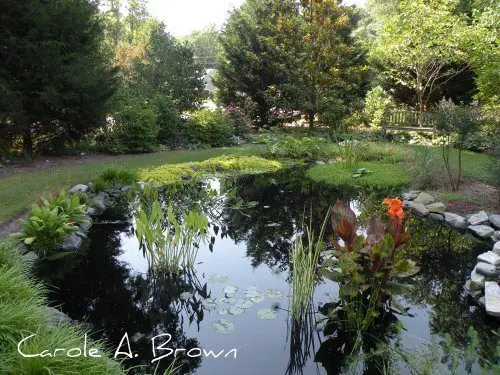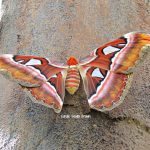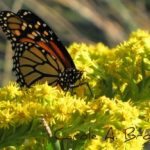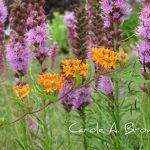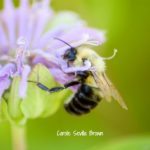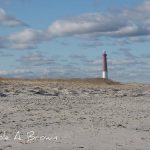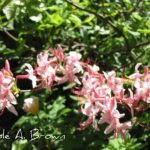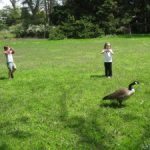Ecosystem Gardening views every property — whether a small residential backyard or acres of woodland or the grounds surrounding your business– as an ecosystem.
If each of us takes personal responsibility for the health of the wildlife on our property, we can improve the health of our planet. Because habitat loss due to human action is the number one cause of wildlife declines, we can each choose to become stewards of our own land. We can choose to “give a little back to wildlife” by creating welcoming habitats for wildlife in our gardens.
In the Ecosystem Garden, plants are chosen, not as specimens, but for the role that they play in the ecosystem and the benefits they provide to wildlife and the protection of ecosystem services and biodiversity. Each of us is a steward of our land and the choices we make on our properties can either be helpful or harmful to that ecosystem. The goal of Ecosystem Gardening is to make the choices that are most beneficial to wildlife and to conservation of natural resources.
See:
Ecosystem Gardening: Give a Little Back to Wildlife
The language of Ecosystem Gardening: Being Specific
Four Steps to a Beautiful Wildlife Garden
These choices include recognition of the following areas:
Sustainable Landscaping
This may be one of the most over-used and misunderstood terms in common usage today. For our purposes, we mean reducing or eliminating the consumption of fossil fuels, eliminating the use of chemical toxins (fertilizers, herbicides, pesticides), reducing the need for irrigation, managing rain water where it falls, using local and recycled materials, reducing soil erosion, managing leaves and other plant debris on-site, and choosing locally appropriate materials.
See:
Reduce Your Lawn and Create a Love Letter to Wildlife
Sustainable Landscaping for Gardeners
Why Lawns are not sustainable in Ecosystem Gardening
Justin Timberlake says golf CAN be green
Beware Greenwashing when it comes to your Ecosystem Garden
Soil Health and Conservation
Our standard development and construction practices destroy topsoil either by removal or compaction. Topsoil erosion is a serious problem and petroleum-based fertilizers, pesticides and fertilizers kill all of the organisms that keep the soil healthy and productive. There is an old gardening maxim that states “feed the soil, not the plants,” which illuminates the priority of healthy soil.
See:
I am the Lorax: I Speak for the Leaves
Life in the Leaf Litter: Don’t Throw a Good Thing Away
Water Conservation in the Ecosystem Garden
In the U.S., 30% of potable water on the East Coast, and 60% on the West Coast is used for irrigation, mostly for lawn irrigation and agriculture. As many residents of southern California and Arizona already know, there is not enough clean water available in these areas for drinking and cooking, let alone watering the lawn. Continued unsustainable use of clean water is already causing serious problems in the southwest, and this pattern is only expected to worsen as time goes by.
See:
Managing Rainwater in Your Ecosystem Garden
Ecosystem Gardening in Practice: Installing a Green Roof
Resources Guide Part 2: Water Conservation
Native Plants in the Wildlife Garden
The native insects, birds, and other animals of this country co-evolved with the native plants indigenous to this land. Many native insects are specialists whose lives are dependent on one or a very few species of native plants. Landscapers and nurseries for years have thrived on introducing their clients to the newest plants from abroad. A landscape devoid of native plants will also be devoid of native insects, and therefore birds and other animals as well. Many of these introduced plants have escaped the garden environment and are now wreaking havoc in natural areas. These invasive plants out-compete native plants for water and space and are overwhelming and shutting out native plants.
See:
Doug Tallamy: Native Plants Support Local Food Webs
What makes a plant invasive? The first lesson in what NOT to plant
Top 10 best woody plant for wildlife in your Ecosystem Garden
The importance and role of insects to the ecology of the wildlife garden
We are dependent on insects for many ecosystem services such as pollination, control of other pest insects, decomposition of wastes, and transforming the energy of plants into high-quality protein usable by other species for their growth and reproduction. Healthy populations of birds, amphibians, and small mammals are dependent upon healthy populations of native insects as their primary food source. The interaction between insects and plants is an amazing process. Some of these mutualisms have become so specialized that some insects are unable to survive without one particular plant (and vice versa).
See:
Ecosystem Gardening in Practice: How to install a dragonfly pond
Pollinators in the wildlife garden
The recent news about colony collapse disorder in honey bee populations has drawn additional attention to the pervasive decline of native pollinators. Without pollination, much of our food supply is in jeopardy. Private landowners can take many steps to provide for the needs of these pollinators, the planting of native plants being number one. Some of our native plants will become extinct without the pollination service of their co-evolved pollinator. Many flowering plant species are declining and this is in part due to declines in pollinator populations.
Butterfly Gardening
Many gardeners have become interested in butterfly gardens, but most of the literature available on this subject stresses nectar plants (many of them exotic) and not as much the fact that each species of butterfly is dependent on one species (or one family) of plant for use as a host on which to lay their eggs. Conservation must include knowledge of the entire life cycle of butterflies in order to provide for all of their needs and contribute to their survival.
See:
Butterfly gardening for Monarchs: Got Milkweed?
Bird Gardens
Many migratory birds are in trouble, due mostly to habitat loss, fragmentation, and degradation, both here and on their wintering grounds. In this country, we spend billions of dollars on bird feeders, bird houses, and bird seed, but this may be money misspent and detrimental , in that it contributes to the proliferation of species such as House Sparrows and European Starlings (both of which are introduced), and predators or parasites such as Blue Jays and Brown-headed Cowbirds (Blue Jays and Cowbirds are native species, but they are nest predators and parasites. Their populations have greatly increased due to deforestation and increasing “edge effects”; higher amounts of edge areas produce larger numbers of these birds, because the edge increases their access to nests of other birds, such as warblers, tanagers, and vireos), and the urban proliferation of mammal species such as Norway rats, raccoons and opossums. Most neotropical migratory birds are insectivores or frugivores and their needs would be better served by planting insect-attracting or fruit-producing native plants.
See:
One third of U.S. birds in danger: how your Conservation Garden can make a difference
Have a cup of coffee and help save bird habitat
Amphibians in the habitat garden
Amphibians, due to their life history traits of interaction with all parts of the environment, from fresh water through upland elements, seem to be early warning indicators of unhealthy ecosystems. Unfortunately, many species of amphibians, including frogs, toads and salamanders are in decline due to habitat loss, fragmentation, and destruction as well as poisoning, the effects of global climate change, and UVB radiation. With proper understanding of their total life cycle, private landowners can provide many elements necessary for amphibian survival.
See:
5 ways to help amphibians in your Ecosystem Garden
Mammals in the wildlife garden
While large mammals require much more space than may be available on private land, properly managed corridors may enable mammals to find safe passage from one reserve to another. Many smaller mammals are important links in the food web and provide many services as well. Proper attention to their needs is easily accomplished on smaller parcels of land. Some species of special concern are black-footed ferrets, many mice, flying squirrels, most species of bats, and prairie dogs.
Ecosystem Gardening involves awareness and integration of all of these issues and the desire to help wildlife by making our properties more hospitable to them. We can choose to become stewards of our land, managing it to increase biodiversity, contribute to ecosystem services, and conserve natural resources.
More From Ecosystem Gardening:
Submit your review | |

